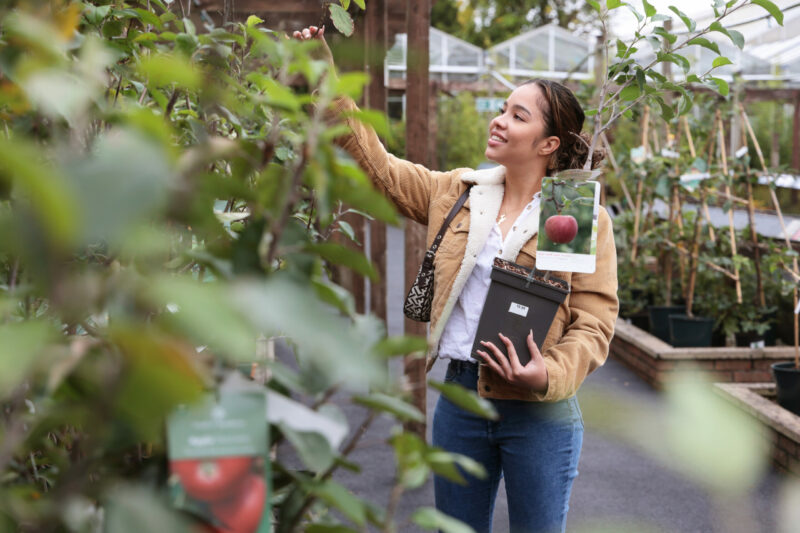Fruitful investments

It pays to do your homework before purchasing a fruit tree to plant over winter. Words Rachel Vogan
At present I am enjoying fruit I grew and preserved over summer: stewed apples, peaches, apricots and
plums. That sense of gratification I get when I enjoy it on my cereal or served hot in a pie or crumble makes it worth every bit of the time, energy and care it took to pick and produce the fruit
In my world, it’s survival of the fittest when it comes to fruit trees. I only grow fruits that I know will produce a reliable crop with little care or maintenance (other than watering, pruning every year or two, and feeding). I can’t climb up on ladders to do anything like covering frost-sensitive crops with nets, nor will I wait 10 years for something to fruit. Therefore, I do the groundwork before planting anything new.
Fruit tree essential needs
Room to grow
Site selection is critical. Fruit trees are long-term tenants, therefore consider carefully what you plant where. Choose a position where a fruit tree can fully mature and develop. Avoid trying to squeeze in one more plant down the back corner on the off-chance it may grow.
Full sun
No compromise here; hardly any fruit trees thrive without at least four hours of sunlight per day. Generally, more sun equals more flowers, which equals more fruit.
Sound roots
Good soil, drainage and wind protection are vital. It makes sense that the better the soil, the more likely your harvest will be abundant. The same goes for protection against strong winds that can blow the fruit from the trees. Poor drainage will cause issues for most fruit trees, too.
A mate to pollinate?
Before investing in any fruit tree, find out if you need more than one tree for successful pollination. Some fruit trees, such as apricots, citrus and peaches, are self-fertile, which means bees are the mechanism for moving pollen around from one flower to another. Even if you only have one tree, it will bear fruit.
But some fruit trees need a mate to pollinate: a friend with ultimate benefits. Those requiring a mate to pollinate include certain varieties of apple, plum, sweet cherry, blueberries, pears and feijoas. If you’re considering growing any of these, ensure you invest in the correct pollinating partner to cohabitate. Some plants are even grafted with their ideal pollination mate on the same plant.
Plant partners do not need to be side by side; in fact, they can be next door, they just need to be within a few hundred metres of the fruiting plant. So, if space is limited, chat up your neighbours and share the load by planting one tree each, then sharing the produce.
Portable fruit trees
Many fruit trees happily thrive in large planters or barrels, making growing your own fruit an option when renting, on the move or in a tiny home. A welcome benefit of growing fruit trees in something portable is that they can be moved to a warmer position over winter. This extra protection may be all that is required to get fruit from a marginal crop in your area.
Over recent decades, fruit tree growers have adapted to the downsizing of sections by producing grafted fruit trees onto dwarf root systems. This type of growing method limits the eventual size of the tree without compromising on the fruiting ability of the plant, making it a win-win situation. While the eventual tree size is reduced, the fruit size isn’t any smaller than it would be on the more traditional,
taller rootstocks. Two or three apple varieties can be grafted onto one tree trunk. For example, if you dual graft ‘Royal Gala’ and ‘Braeburn’ apples, the ‘Royal Gala’ apples will ripen first, in late summer, then the ‘Braeburn’ apples in autumn, thus extending the fruiting season.
Dwarf cultivars of citrus are widely available. These are ideal for growing in areas with limited space and in containers. Feijoas vary in size too. Large cultivars, such as ‘Mammoth’, need more room to mature, whereas the smaller, bite-sized hybrid ‘Bambina’ is perfect for life in a tub. Dwarf grafted cultivars of cherries are popular too. Look for ‘Lapins’ or ‘Stella’ on dwarf rootstocks. The smaller trees make it easier to pick the fruit and chuck nets over to protect the crop from the birds.
10 fruits that thrive in pots
- Pip fruit: apples, pears and quince
- Currants and gooseberries
- Citrus: lemons, limes and mandarins
- Olives
- Figs
- Feijoa
- Blueberries
- Pomegranate
- Stone fruit: peaches, nectarines and apricots
- Berries and brambles
